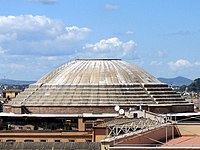
Photo from wikipedia
Under the repeated loading, the continuous impact and friction of tires on aggregates resulted in some changes in their morphology, which may cause rutting, decrease in skid resistance, and fatigue… Click to show full abstract
Under the repeated loading, the continuous impact and friction of tires on aggregates resulted in some changes in their morphology, which may cause rutting, decrease in skid resistance, and fatigue damage of the road. In order to explore specific changes in coarse aggregate morphology, the Los Angeles abrasion test was used to simulate the force exerted on coarse aggregates and the morphologies of different aggregates before and after abrasion were compared. Four types of coarse aggregates were selected and their mineral compositions were analyzed by X-Ray Diffraction (XRD). The morphological characteristics were measured using Aggregate Image Measurement System (AIMS-Ⅱ), including angularity, surface texture, sphericity and Flat and Elongation (F and E) ratio. Results showed that the angularity value for each type of aggregates significantly reduced after abrasion and the angularity reductions of various aggregates were consistent with the results of abrasion test, indicting the angularity reduction was the main component of abrasion loss. Whereas, there was no significant different between the surface texture of coarse aggregates before and after abrasion. For shape properties, both sphericity and F and E ratio results showed that aggregates with excessively high F and E ratio were easy to break, which might cause rutting and were harmful to pavement. Therefore, for pavements with high performance requirement, coarse aggregates with large angularity and low abrasion value should be preferred, whereas the quantity of particles with excessively high F and E ratio should be controlled.
Journal Title: Materials
Year Published: 2020
Link to full text (if available)
Share on Social Media: Sign Up to like & get
recommendations!